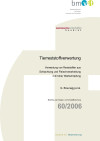Suchergebnisse
Colors of Nature - vegetable dyes in practice
By means of optimization of the production of vegetable dyes and dyeing technology, the vegetable dyestuff "Colors of Nature" will achieve market maturity. In co-operation with farmers and companies of the textile, food processing and wood working industry there has been developed a competitive product throughout the value chain, which will not only yield an ecological advantage, but also generate regional creation of value.
Maisgranulat zur Immobilisierung von Lipasen
Das Ziel des Projekts ist die Entwicklung einer neuen Methode zur Herstellung von Biodiesel und ähnlicher Verbindungen. Durch heterogene, enzymatische Katalyse ist es möglich, die Nachteile der herkömmlichen Biodieselproduktion auszuschließen. Lipasen werden, um das Preis-Leistungsverhältnis des Prozesses zu verbessern, auf unlöslichem Trägermaterial immobilisiert. Als neues Trägermaterial wird der kostengünstige und leicht zugängliche nachwachsende Rohstoff Maiskolbengranulat verwendet. Das Ziel des Projektes ist es, ein ökonomisches, gut funktionierendes, industriell anwendbares Verfahren für die Produktion von Estern niederer und höherer Alkohole zu entwickeln.
Material utilization of end-of-term textiles
Mechanical processing of the non-reusable part of collected end-of-life apparels (e.g. cutting, sifting, etc.); development of marketable application for the obtained short fibers in the field of construction materials (e.g. bitumen modification)
Öko-Informationscluster Mödling
Für ein ausgewähltes Industriegebiet (Mödling) werden Möglichkeiten der stofflichen Verwertung von Reststoffen ausgearbeitet und in ökologischer und ökonomischer Hinsicht auf Realisierbarkeit geprüft.
Produktion der Zukunft – Ausschreibung 2016
Im Rahmen der FTI-Initiative Produktion der Zukunft des BMVIT werden 2016 über 16 Mio. Euro für die themenrelevante Forschungsprojekte bereitgestellt.
Stoffliche Verwertung der textilen Restfraktion
Verwertung des im Zuge der Aussortierung von brauchbarer Second-hand Bekleidung aus gesammelter Altkleidung anfallende textile Abfall soll einer Wiederverwendung zugeführt werden; Entwicklung von automatisierten, mechanischen Verfahren zu Aufbereitung; Vermeidung von Abfall.
Colors of Nature - Pflanzenfarbstoff in der Praxis
Durch die Optimierung der Farbstoffherstellung und der Färbetechnologie wird Pflanzenfarbstoff "Colors of Nature" marktfähig. In Kooperation mit den Unternehmen der Textil-, Agrar-, lebensmittel- und holzverarbeitenden Industrie wurde entlang der Wertschöpfungskette ein konkurrenzfähiges Produkt entwickelt, das nicht nur ökologische Vorteile bringt, sondern auch regionale Wertschöpfung generiert.
Adsorbent Materials of Residues from Corn Cob
Development and testing of processes to produce adsorptive materials from agricultural residues of corn production with focus on corn cob grit as oil bonding agent (e.g., applicable to the remediation of oil spills).
Pilotprojekt Biogasbehälter in Fertigteilbauweise
Errichtung eines Biogasbehälters in Fertigteilbauweise und als Erweiterung einer bestehenden Anlage in Bruck an der Leitha in Betrieb genommen. Diese Methode versprach eine Reihe von Vorteilen, warf aber auch mannigfaltige technische Fragen bezüglich Dichtigkeit und Konstruktion auf, die im Rahmen dieses Pilotprojekts überprüft wurden.
Gewinnung von adsorptiven Produkten aus Maisreststoffen
Entwicklung und Erprobung von Verfahren zur Erzeugung adsorptiver Produkte aus Reststoffen der Körnermaisproduktion mit Schwerpunkt auf der Spindelverwertung in Hinblick auf ölbindende Materialien.
Watersorption - Water absorption of Wood Plastic Composites
Analysis of the water absorption in Wood Plastic Composites (WPC) in order to develop solutions to decrease and stop water absorption. This enables a big variety of new applications made of WPC and brings economical and ecological advantages for the polymer processing industries.
Bioethanolproduktion aus Lignocellulosen mit Steamexplosion
Aus den Abfallstoffen Stroh und Holz soll durch geeignete Vorbehandlung in dezentralen Anlagen Bioalkohol produziert werden. Klimarelevante Abfallstoffe werden zu Biotreibstoffen annähernd CO2-neutral umgewandelt, wobei eine regionale Wertschöpfung vorgesehen ist.
Tierreststoffverwertung

Verwertung von Reststoffen aus Schlachtung und Fleischverarbeitung mit hoher Wertschöpfung
Schriftenreihe
60/2006
G. Braunegg et al.
Herausgeber: BMVIT
Deutsch, 100 Seiten
Downloads zur Publikation
Pilot-Biogas plant consisting of prefabricated units
Construction of a biogas tank built of prefabricated reinforced concrete elements, erected and operated at an existing biogas plant in Bruck an der Leitha. The precast concrete technology promised a lot of advantages but also posed a lot of questions that had to be solved. These problems considered especially the sealing method and the general construction with precast concrete elements.
Watersorption - Wasseraufnahme von Wood Plastic Composites
Untersuchung von Wasseraufnahme und -transport in Wood Plastic Composites (WPC), um Lösungsansätze zur Verringerung und Unterbindung der Wasseraufnahme zu erarbeiten. Dies eröffnet dem Werkstoff eine Vielzahl neuer Anwendungsmöglichkeiten, was sowohl ökonomische als auch ökologische Vorteile für die kunststoffverarbeitende Industrie bringt.
Konzept für die Vorbereitung des Demoprojekts "KernCraft Austria"
Zusammenführung bisheriger Aktivitäten im Bereich der Kaskadennutzung von Steinobstkernen ("KernCraft Austria") und Planung eines Demonstrationsprojektes zur wirtschaftlichen Umsetzung von KernCraft Austria.
Maize Cob Board (MCB) - Light weight material from agricultural by-products
Maize cobs accrue as an agricultural by-product can be used for a core material of light weight panels with good material properties and insulation characteristics. The aim was to work out a concept for the production and optimisation of material properties.
Informationssysteme für Öko-Industrie-Cluster - Fallstudie Industriegebiet Mödling
Entwicklung eines umfassenden, transparenten und benutzerfreundlichen Konzepts zur Vernetzung von Material- und Energieflüssen durch verbesserten Informationsfluss in der Modellregion Mödling an und zeigt die dahinter stehende Reduktion der Umweltbelastungen in Verbindung mit ökonomischen Vorteilen für die Betriebe auf.
Apple & pear cascade: more value added in the Mostviertel region through bio-cascading
Creating a concept for the bio-cascading of apple and pear pomace in the Mostviertel region for an increased value added through innovative local products. Development of strategies for the implementation of a pilot plant.
Türblatteinlagen auf Basis nachwachsender Rohstoffe und Reststoffe
Extrusion von nachwachsenden Rohstoffen und/oder Reststoffen zu Schaumkörpern, die nach Zugabe von Klebstoffen zu Platten verpresst und als Türblattmittellage verwendet werden.
